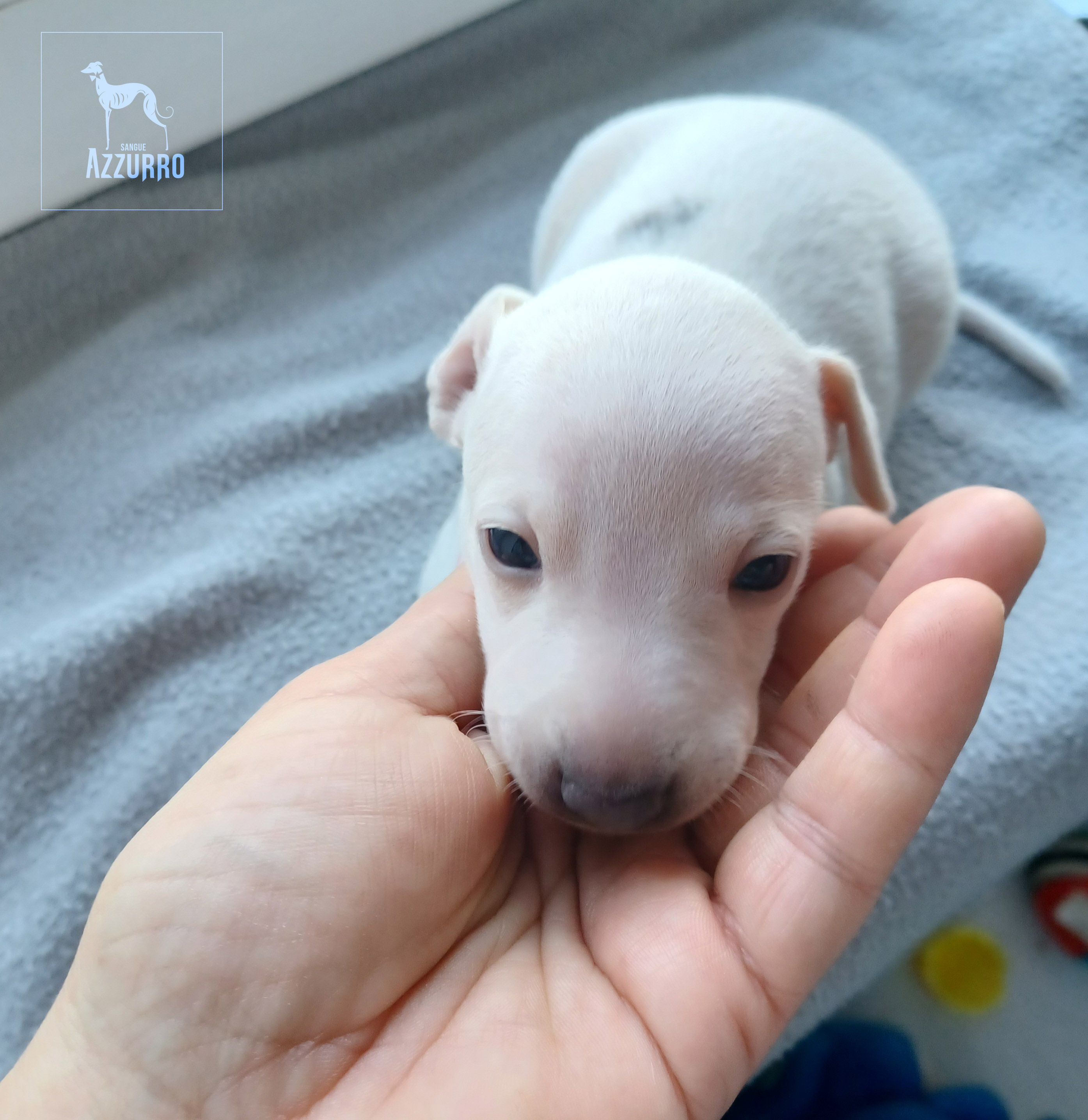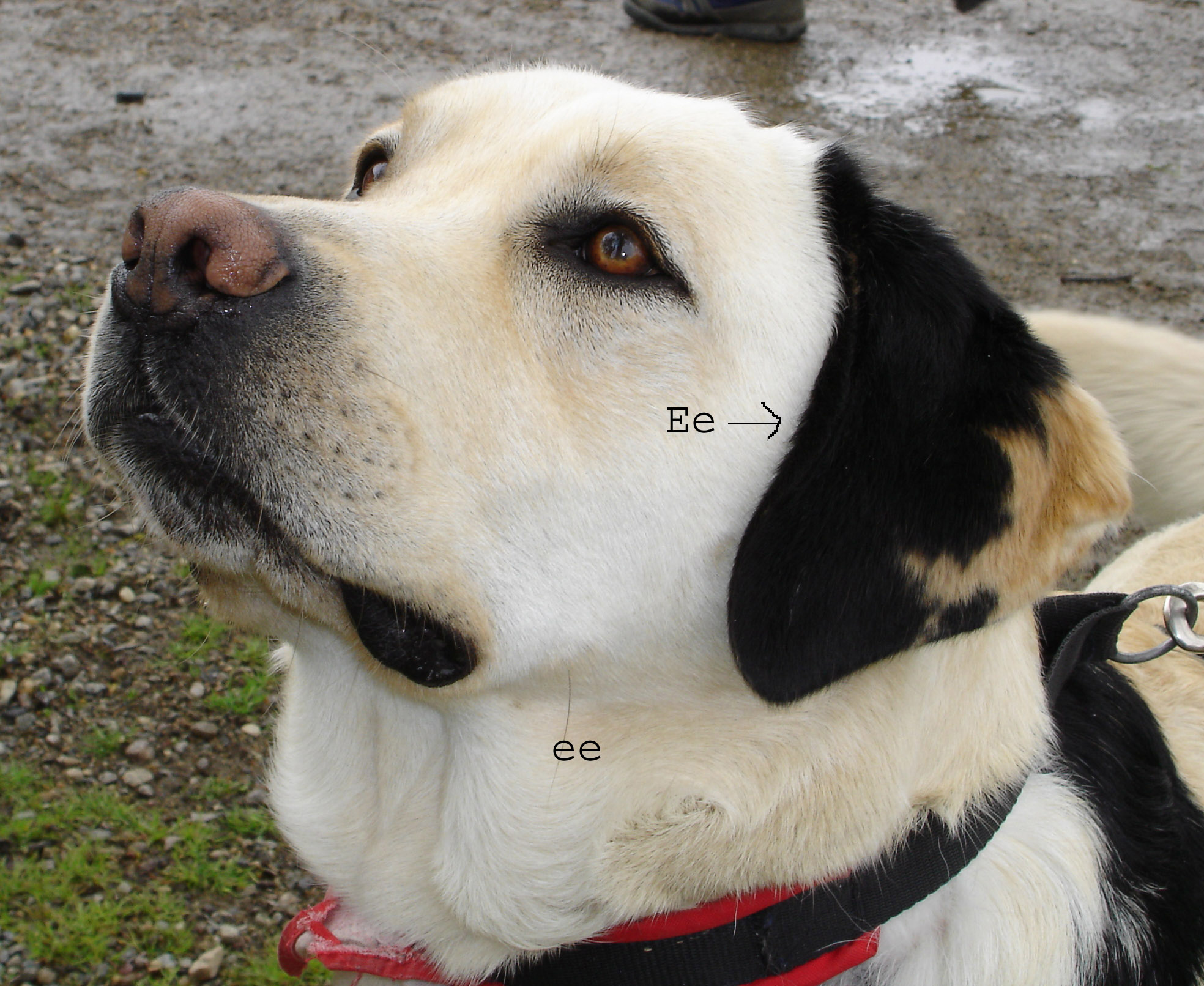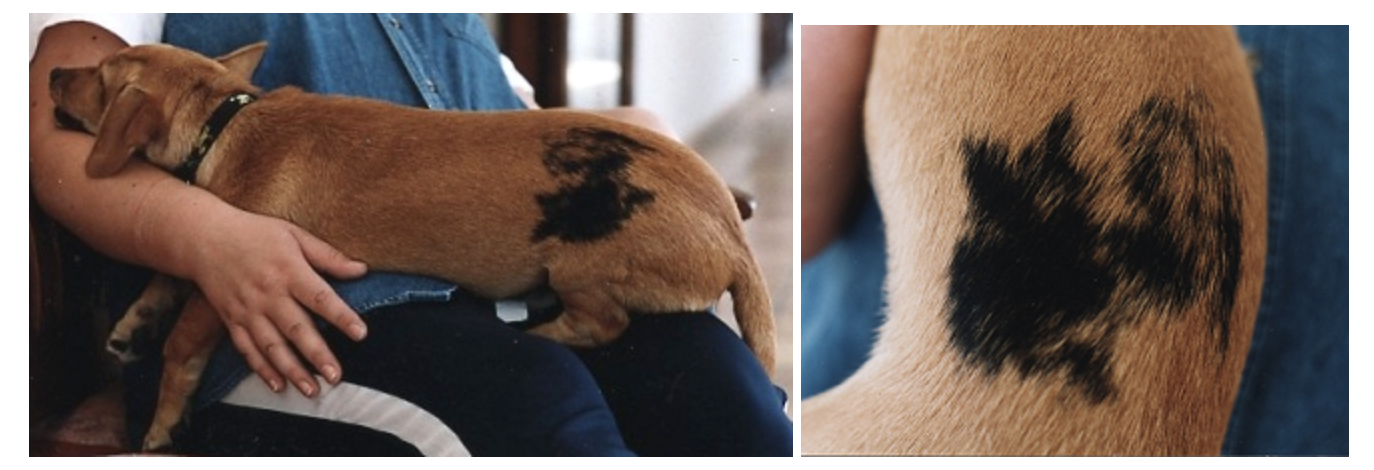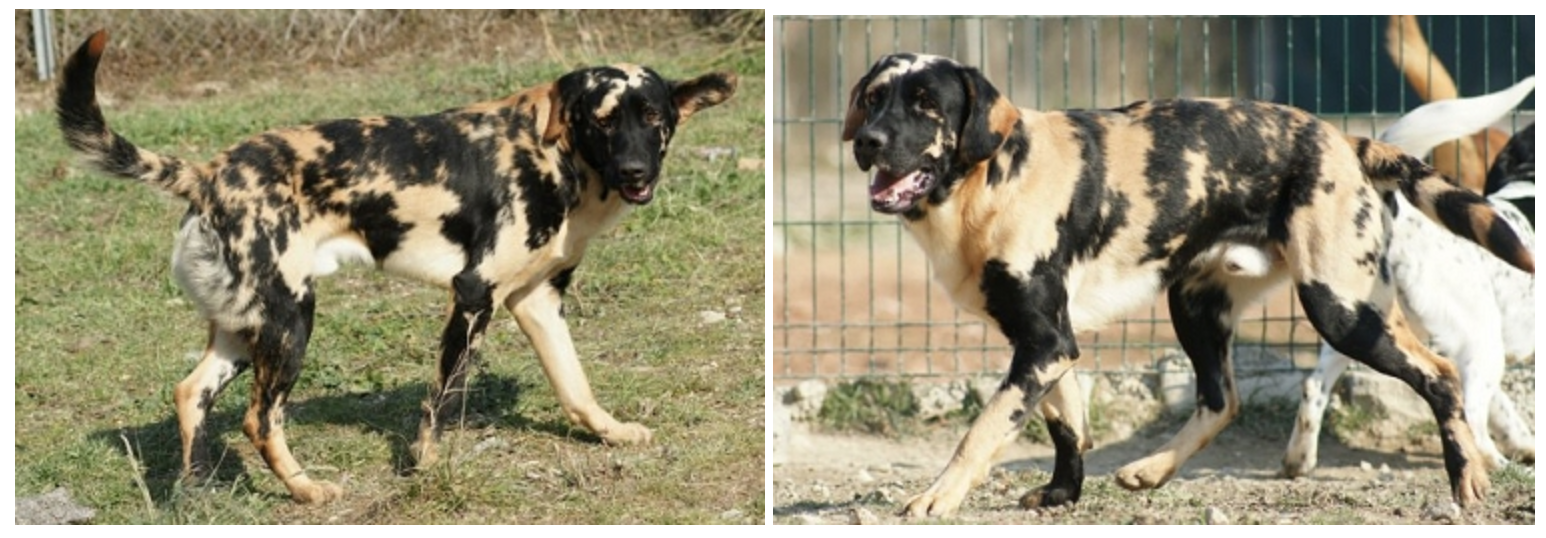Sangue Azzurro
it all revolves around the italian sighthounds

In the litter P, by mating Kromeczka and Coco (Cromosoma Sangue Azzurro & Chartbeat Dominic Decoco), a very original puppy was born, one male between four females, in addition, with a dark spot on his back in the shape of a heart. Apart from esthetics and undoubtedly originality of the puppy, the curiousity arises about of his color?I have been interested in colors inheritance for few years and I organized first training in this field in my breed in 2020, constantly writting to and calling Kasia Fiszer (today my dear friend, then a complete stranger – a kennel judge, a lecturer, a biologist, a teacher and an employee of the Institute of Environmental Sciences in Jagiellonian University and in Tischner European University in Krakow, in a word a woman orchestra, also a breeder!), thus inviting to participate in this fantastic educative adventure of several other breeders of Intalian Greyhounds (Chartbeat, Super Charty i Carskij Borsjatnik). Our meetings with Kasia Fiszer were the longest and the most fruitful, as there were 40 hours of lectures throughout 2020 and 2021, but also an openness and incredible committment of each of us meant that the material expanded with new topics which we discussed with the lecturer. Other breeders have followed our footsteps being inspired by the progress in our breeding and the vastness of our knowledge! Presently trainings in the field of color inheritance have become popular. Good, as more and more people work on colour profiles of their Italian Greyhounds and more consciously connect breeding pairs.
It won’t be an exaggeration if I say that undoubtedly our dog breedings of Italian Greyhounds as first in Europe had complete genetic profiles for their coloring of most Italian Greyhounds in our pack of dogs done. Following our example other breeders in Poland and abroad have started genetically profile their dogs, often consulting myself and my colleagues in private messages.
Increasingly in Europe, in Breed Archive database, Italian Greyhounds genetic profiles of their coloring occur, although small amount of breeders is able to use this information, because as we can see brown or tan color Italian Greyhounds still are born from examined parents, even though it would be enough to look at future parents LOCI, to know that it does not make sense to risk and mate them. Autosomal recessive inheritance is known probably to every breeder, therefore there should not be any surprises.

When this exceptional puppy was born there was brainstorming and browsing the internet at nights, looking for information about mutations that may occur in this color. Creamy color predestinates to somatic mutation as occurs on Poetry Sangue Azzurro.This „defect” in color or „unusual markings” are not surprising in the world of dog color. Our special boy, Poetry Sangue Azzurro, it has a very light isabella color in its brightest shade of cream, known in this breed as cream. Based on his pedigree and parents colors and their genetic color profiles (we do not have genetic color tests for him yet, that clearly confirm the genetic background of the color). He is most likely homozygous recessive at the locus E: ee and also homozygous recessive at locus I: ii, which gives a very light cream color in the phenotype.Such color should be uniform all over the body, light, without a dark pigment - eumelanin. So where does black color come from? The cause of its appearance may be a somatic mutation. Soma – means a body. This is a type of mutation that occurs in body cells, usually affects a group of cells, is quite often described in skin cells and manifests itself as a change in coat color in an unusual way. In the area of the body where black is revealed, a mutation occurs in selected cells, as a result of which the ability to produce dark pigment is restored. In other words, where there is black, the cells of the body most likely have the genotype EE or Ee. And this is most likely the reason for the "uniqueness" of PETRY's color. And the heart shape? He was just marked for love :).
I write carefully "most likely" because there is no way to confirm this thesis with laboratory tests in Europe, so everything I describe is basically my interpretation and the conclusions of a few wise people who are aware of such exceptions. In order to be able to write about the facts, mutated cells would have to be taken from this dark patch of skin for examination.


These somatic mutations reflect only in some colors and can be found e.g. in Labrador retriever, in yellow color, whose genetic background is also determined by genes from locus E and locus I. In this color, such markings are also observed, with different intensity and with different distribution. In September 2022 the breed standard was clarified, mentioning in disqualifying defects every other color than black, yellow, and liver/ chocolate or combination of this colors – yellow and black on one individual is a color eliminating from breeding.
Are somatic mutations hereditary? Most probably not, but we are not certain. To be hereditary a mutation would have to involve changes in genetic material of the reproductive cells and even the term: somatic mutation indicates body cells and it is linked here to a non-standard, dark color. But as far as we are sure - we don’t use such individual for further breeding.

Again light cream dog’s color has shown it’s complex nature. It is relactantly taken up in breeding, quite problematic because of the pigment and unpredictability of effects. Below you can find two articles : „Somatic mutation and Chimera” and „ More than one base color” (source:http://www.doggenetics.co.uk,http://color.ashgi.org).

MORE THAN ONE BASE COLOR SOMATIC MUTATIONS
Sometimes when an embryo is developing one of its skin cells undergoes a mutation. Any cell that is produced by this mutant cell dividing also contains the mutation. Cells originating from other layers of the gastrula, including sex cells, do not originate from the same layer as the skin cells and are not affected by a skin cell mutation. For this reason a dog which has a somatic mutation will not produce its dual color in offspring. CA Sharp has some excellent slide photos of Aussies with somatic mutations. She uses these in her genetics seminars. The photos below are of a registered Golden retriever who underwent a somatic mutation while still an embryo. This phenomenon has also been observed in domestic cats and in ranched foxes.The photos of Seth were supplied by Elaine Reynolds.

This is a registered Golden retriever named Seth. Goldens are genetically black but look golden yellow to reddish due to their (ee) genes restricting the development of black pigment. They're of the same genetic makeup as the Aussies on the "yellow Aussies" page. Goldens are (BB ee) in constitution. This Golden had mutation in a skin cell in which (ee) became (Ee). This allowed the black pigment to form in cells descended from that one original mutant cell. He does not produce puppies with black spots because the mutation occurred only in his skin, not his reproductive organs. If his testes were also completely or partially composed from cells from the original mutation, then he could sire black pups when mated to normal Golden females.

Here is another view of Seth. His body is reddish yellow in color and his nose is black, just like a black nosed yellow Aussie. Where (ee) has been changed to (Ee) he shows black pigment. CA Sharp has a photo of an Aussie in her slide show on whom the reverse mutation has taken place. This normal black tri Aussie (B- EE) or (B- Ee) has a yellow patch on his hip that is (B- ee) like this Golden. He also didn't throw this trait to offspring, since the mutation took place in a skin cell, not a gonadal cell.

This is a photo of Spotty, a registered Labrador retriever courtesy of the Matessers, owners of a kennel in Italy. Spotty's mom is a black Labrador, and his dad is a yellow Lab. His siblings are all either yellow or black. DNA testing was done to verify parentage. But during Spotty's embryonic development a skin cell mutated from ee (yellow) to Ee (black). All the descendants of that mutated cell produce black pigmentation. Could he sire black puppies in addition to yellows if mated to a yellow? Possibly. His left testicle is black; if the cells inside it are of the same origin as the black cells on the scrotum, they would produce sperm containing E as well as e.

Here is a closeup of Spotty's face as an adult. He is clearly a mosaic of yellow and black rather than a black pinto with the white spotting gene. He is actively shown in canine sports, where his dual color catches a lot of attention. It is equally possible for a dog to be a chocolate/yellow mosaic or a chocolate/black mosaic. Another possibility is that two embryos merged very early in development, producing a Chimera. But DNA tests reveal only one dog present.
SOMATIC MUTATIONS AND CHIMERA
A somatic mutation is a mutation that occurs in the body cells after the embryo has begun to form. Cells are divided into two categories - germline cells (i.e. gametes - sperm and eggs) and somatic cells (all other body cells). When a mutation occurs at the point of conception (when the first cell begins to replicate) then this mutation may enter the germline and so be passed on to future generations, but after this point the two types of cell replicate separately and any mutations occuring in the somatic cells will only be passed on to the descendents of those cells and will not be passed to the next generation. This is because only the information carried in the gametes will go on to form a new individual (of course, mutations may well happen in the gametes too during the individual's lifetime, and these mutations will be passed on).
This may sound complicated, so perhaps an example will make it clearer. Cancer is a somatic mutation. Sometimes a mutation occurs in a cell that makes the cell "immortal". Most cells can only replicate a certain amount of times, but when this particular mutation happens the cell is able to replicate itself indefinitely (this is the biological definition of immortal), and this is how tumours form and also why they can be very difficult to get rid of. However, although the predisposition to cancer may be genetic, cancer itself is not as it occurs as a mutation in cells that will not go on to form new individuals.
If a pigment somatic mutation takes place during the development of the embryo, patches of another colour may appear on the animal. This is often seen as black patches on recessive red Labradors and Golden Retrievers. The painting at the top of the page shows what this might look like. It is not certain why pigment mutations seem to appear in these breeds more than others, however it's possible that the recessive red gene is unstable and particularly prone to mutation. All it takes is for one cell to mutate early on in development - then all cells descended from that one as the embryo grows will be the different colour. Due to the mutation these patches effectively have a different genotype to the rest of the dog, and this is sometimes known as mosaicism.
Sometimes you will see a colour test result on a dog that appears to show three or more alleles on a locus. This is particularly common on merles, and also sometimes seen on the B locus. This is due to mosaicism. It is generally visible on merles (they will often have large areas of solid colour), but on colours such as liver/brown, the different b alleles express the same and you won't be able to tell from looking at the dog that they are a mosaic.
A very rare form of mosaicism is the chimera. A chimera is a single animal that is the combination of two separate embryos. You may have heard this term used to describe creatures with the DNA of two different species spliced together, such as human/mouse embryos created in labs, but it also occurs naturally when two fertilised eggs combine very early in development. Effectively, the resulting animal is two individuals in one. It has patches of one set of DNA and patches of the other as well. Sometimes it can be impossible to tell a chimera without genetic testing (particularly in humans), but in some cases the resulting animal may be a combination of two different colours. I do not know of any proven dog chimeras, but the effect may be similar to the somatic mutations already discussed, but more extensive (roughly 50/50 of each colour). Chimaeras in some species can produce a brindle-like pattern.

These pictures were submitted by Dr Anna Laukner and show a small dog from a village in Ibiza with a somatic mutation. Black patches on a red base is the most commonly seen somatic mutation. If the black on this dog was due to the sable gene, it would be much more evenly distributed through the coat.

This incredible Labrador appears to show somatic mutations, but is a possible chimera due to the extent of his patching. These photos were taken at a rescue centre in France and sent to me by Damien Ricco but we have been unable to locate the original photographer. If you took these photos then please contact me and I will be happy to add credit (or remove them if you wish).

Maza's striking face markings could be a somatic mutation or may just be unusual piebald markings. They appear to follow the opposite pattern to the usual face markings seen on dogs with white spotting. The beautiful Maza is owned by Jenny Ban.

